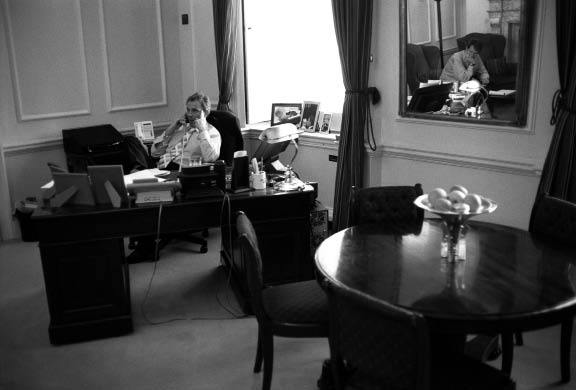The Prince, according to Machiavelli, ‘should appear, to see him, to hear him, all compassion, all good faith, all integrity, all piety’ — which might be translated into Basic Blairish as ‘should appear a pretty straight kind of guy’ — but, as the Florentine Father of Spin emphasised, it was a great deal more important to seem to have, rather than actually to have, these qualities.
The Prince, according to Machiavelli, ‘should appear, to see him, to hear him, all compassion, all good faith, all integrity, all piety’ — which might be translated into Basic Blairish as ‘should appear a pretty straight kind of guy’ — but, as the Florentine Father of Spin emphasised, it was a great deal more important to seem to have, rather than actually to have, these qualities.
Nick Danziger took a remarkable set of photographs of Tony Blair, when Danziger and the journalist Peter Stothard ended up, through an unplanned stroke of fortune, following the prime minister around for 30 days before the beginning of the second Gulf war. Danziger’s images are the first to greet the visitor at Portraits and Power, a thought-provoking exhibition, in the city that gave us Michelangelo, the Medici and Machiavelli.
Indeed, the present show of photographs and videos by 18 contemporary artists from around the world was planned in parallel with the splendid exhibition upstairs in Palazzo Strozzi devoted to Bronzino, who immortalised the Medici in paint in the mid-16th century. On his second day out, Danziger took an eloquent picture of Blair in his shirtsleeves in his ‘den’ at No. 10 on the phone to Yasser Arafat, the photographer at the same time catching unawares that power behind the throne Alastair Campbell, listening in, out of shot but reflected in a mirror.
In ‘Tea before first War Cabinet’ the men huddle in conspiratorial groups, Brown looking baleful even by his own standards, all firmly ignoring in ungentlemanly fashion the solitary woman in the room. And in ‘Helicopter Flight’, headphones on, hands clasped as if in prayer and eyes raised heavenwards, the former prime minister seems to be communing with the Almighty.
Helmut Newton, a fashion photographer most known for his glossy, glamorous images of women in various states of undress and often in mildly perverse fetishistic situations, might seem an odd choice as a portraitist of Mrs Thatcher. Although he was an ardent admirer, she sat for him reluctantly, only after her resignation. But Newton produced a luminously powerful image which, with its formality and hagiographic intent, could for once be justly described as ‘iconic’.
Sharing this room, too, are life-sized portraits of the last two great dictators of the 20th century: Fidel Castro and Pope John Paul II. There is something disconcerting about these, which is explained when one discovers that Hiroshi Sugimoto created them by ingeniously lighting and photographing waxwork dummies to make them look more real.
Annie Leibovitz’s 2007 much-publicised shoot of Queen Elizabeth II at Buckingham Palace is represented by three final images and a video here of the session, an event not without its comic moments. Having requested her sitter to don full regal dress for the occasion, the resolutely dressed-down Ms Leibovitz asks the Queen to remove her tiara to achieve a ‘less dressy’ effect, to which the monarch replies, indicating the sumptuous apparel of the Order of the Garter she is wearing, ‘Less dressy, what do you think this is?’
Attempting to depict the kind of power that is essentially faceless but nonetheless oppressive offers particular challenges. The Swiss Jules Spinatsch records the paralysing effects international circuses such as the World Economic Forum and G8 have on their host cities, reducing them to a state of siege to protect the visiting bigwigs. The artist even surreptitiously installs his own surveillance cameras to film his own footage of the sinister, police-state atmosphere created by these summits.
The geographer and artist Trevor Paglen has spent a decade compiling a global map of the routes and stopping points, on display here, of secret rendition flights run by the CIA and US military. These locations are carefully shielded from the public gaze, but he has managed to take long-distance shots of some, even using equipment designed for space exploration that can capture an image 100 kilometres away.
Extreme inequalities of wealth and power are exposed in a nearly hour-long video by the Neapolitan-born filmmaker and architect Francesco Jodice, shot in 2009 in Dubai, a city behind the glittering glass and concrete façade of which lies a rigid system of economic and social segregation. The high life led by the few there is built on the backs of tens of thousands of labourers, mostly from the Indian subcontinent, who are ruthlessly exploited — a stark truth that Jodice unfolds by juxtaposing contrasting images and voices and allowing them to speak for themselves.






Comments